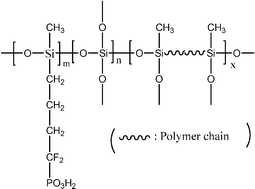Synthesis and properties of phosphonic acid-grafted hybrid inorganic–organic polymer membranes
Abstract
A class of

* Corresponding authors
a
Center for Innovative Fuel Cell and Battery Technologies, School of Materials Science and Engineering, Georgia Institute of Technology, Atlanta, GA, USA
E-mail:
meilin.liu@mse.gatech.edu
Fax: +1-404-894-9140
Tel: +1-404-894-6114
b Materials Engineering Department, Toyota Technical Center, USA, Inc., Ann Arbor, MI 48105, USA
c Material Engineering Division II, Vehicle Engineering Group, Toyota Motor Corporation, Toyota, Aichi 471-8572, Japan
A class of

 Please wait while we load your content...
Something went wrong. Try again?
Please wait while we load your content...
Something went wrong. Try again?
S. Li, Z. Zhou, H. Abernathy, M. Liu, W. Li, J. Ukai, K. Hase and M. Nakanishi, J. Mater. Chem., 2006, 16, 858 DOI: 10.1039/B512389E
To request permission to reproduce material from this article, please go to the Copyright Clearance Center request page.
If you are an author contributing to an RSC publication, you do not need to request permission provided correct acknowledgement is given.
If you are the author of this article, you do not need to request permission to reproduce figures and diagrams provided correct acknowledgement is given. If you want to reproduce the whole article in a third-party publication (excluding your thesis/dissertation for which permission is not required) please go to the Copyright Clearance Center request page.
Read more about how to correctly acknowledge RSC content.
 Fetching data from CrossRef.
Fetching data from CrossRef.
This may take some time to load.
Loading related content
